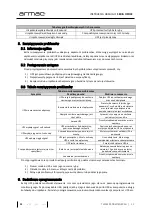
YOUR SOURCE OF ENERGY
|
20
MANUAL
| OFFICE SERIES
PL
EN
HU
RU
2.4
The importance of LCD screen elements
(1)
Power supply (AC) input voltage,
(2)
Output voltage,
(3)
Battery capacity,
(4)
Load level,
(5)
UPS is in battery mode (DC),
(6)
UPS is in the power supply mode (AC),
(7)
Automatic UPS launch after power supply (AC) restoration,
(8)
Fan operation (Models without the fans will not include this indicator),
(9)
Signals issued by the UPS are turned off. In the event of overload or low battery, the UPS will emit
sound signals regardless of the settings.
2.5
Connecting the device to the mains
To connect the UPS to the mains, use the power cord and plug it into a verified 3
-
wire, grounded power
outlet. Do not connect to any surge protectors, dividers or power strips. Remember to have UPS directly
connected to the power outlet.
NOTE
: When using the "cold start" feature, it is unnecessary to connect the UPS to the power supply
.
2.6
Connecting the devices (loads)
To sustain the device operation in the event of power failure (AC), connect it to the power output at the
back of the unit. Do not use any adapters or dividers (with different outlets) to replace the output socket
.
2.7
Operation
2.7.1
Turning the UPS on
To turn on the device, press the power button (ON/OFF) located on the front panel. UPS now will be ready
for use.
2.7.2
Turning the UPS off
1)
In
line / mains power mode (AC:
To turn off the unit, press the power (ON/OFF) located on the front panel for at least 3 seconds.
UPS will shut down the power connected to the rear load and go into standby mode
.
3
4
1
7
8
9
2
5
6
















































